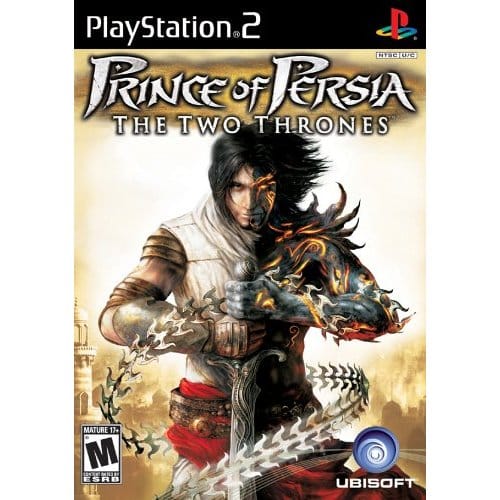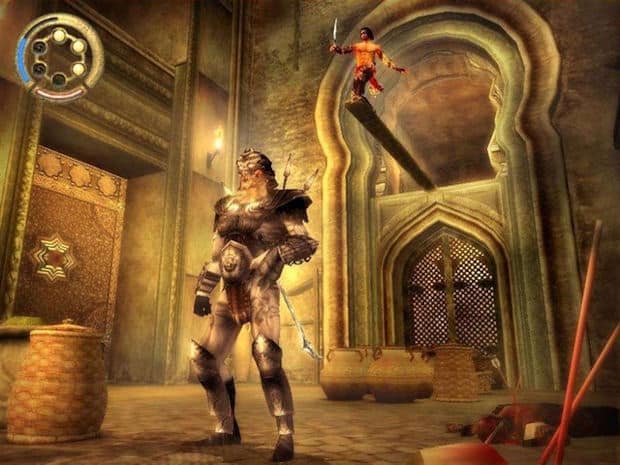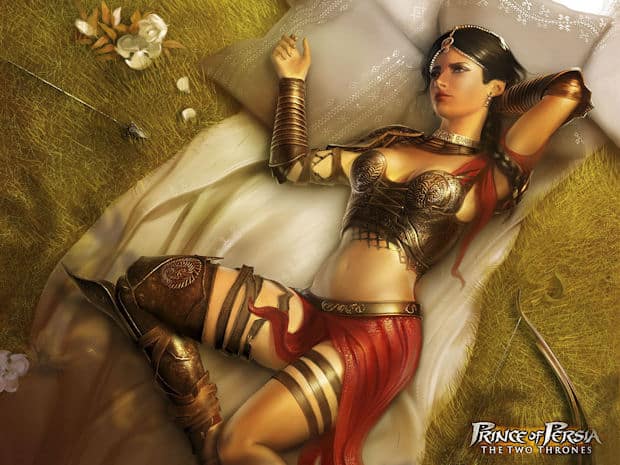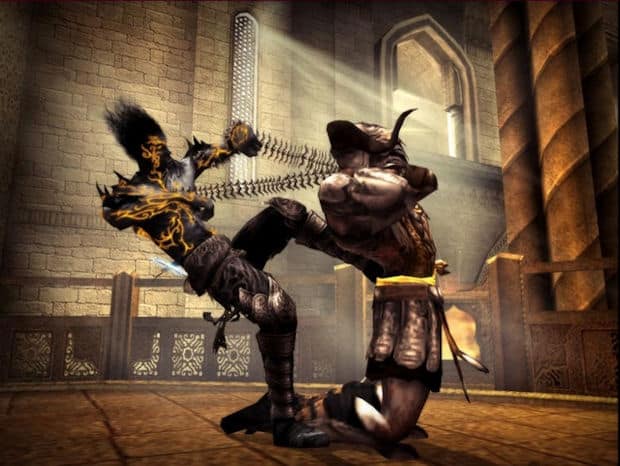
Prince of Persia: The Sands of Time will be remembered for two things: its revitalization of the platforming genre (without need of the “kiddy” attire) and almost ungame-like narrative. Its sequel Warrior Within will be remembered as an abandonment of these ideals; a return to shallow video game tropes paraded about in all their triteness. The Two Thrones attempts to meet these two games in the middle; a pastiche of both flavours, borrowing graciously and carving a new identity for itself from within the hybridity.
System: PlayStation 2, GameCube, Xbox, Microsoft Windows PC, Wii and PSP (titled Prince of Persia: Rival Swords on Wii and PSP)
Genre: Adventure, Platforming
Release date: December 1st, 2005 (April 3rd, 2007 Wii & PSP)
Players: 1
Developer: Ubisoft Montreal
Publisher: Ubisoft
Origin: Canada
Does Ubisoft succeed in this case? Mostly. Is the platforming still great? Why, yes it is. Is it better than Warrior Within? Most certainly. Is it worth putting up with the Warrior Within influences for the charred remains of Sands of Time… Did I mention the platforming is still great? Whether or not you should invest in The Two Thrones ultimately comes down to how hungry you are for more PoP 2.0 platforming goodness. If you want more, The Two Thrones definitely delivers and in a package more digestible than Warrior Within.
Watch the epic Prince of Persia: The Two Thrones TV spot.
Key Game Features:
Whilst The Two Thrones might fail to strike a perfect balance, it does still indeed have a balance and that itself is worthy of investigation. The core problem with The Two Thrones is that it borrows from previous games without understanding what fundamentally made the borrowed material effective in their respective titles.
For instance, The Two Thrones features the narration of Kaileena, the Prince’s lover (see Warrior Within) who *SPOILER ALERT* is murdered early on in the game. *SPOILER ENDS* Her voiced narration, which runs over the top of gameplay and various cut scenes, is a narrative technique borrowed directly from Sands of Time. In Sands though, the narration (as spoken by the Prince) is indicative of the overarching narrative itself; it’s a narrative inside a narrative. That is, at the beginning of the game the Prince enters Farah’s bedroom and tells her a story, the story is his depiction of the events which you play out in game. So the player is engaging in the re-enactment as the Prince narrates. Eventually the Prince finishes narrating his tale (concluding the re-enactment) before the Vizier enters to murder the Prince, giving way to the final battle. The Vizier’s appearance gives credence to the Prince’s tale as being true. It’s all rather marvelously woven together (although if you didn’t understand my poor description a more eloquent elaboration can be found in this Time Extend POP article).

In The Two Thrones though there is no meta-level story telling within the overarching narrative which renders Kaileena’s narration meaningless. Ubisoft does attempt something of a “zoom out” of the trilogy at the end, attempting to somehow link everything to Sands of Time, but it’s a total after thought. It’s not a complete fail though as, according to developers, her role is to be the objective overseer 3rd party who watches over the conflict, in which she follows out the role well.
The narrative joints between Sands of Time and Warrior Within were forcibly creaky. In The Two Thrones though the assumptions made between games are further farfetched and disjointed, only confusing to the player, particularly players new to the universe. Even as someone who has intently played through the previous games, I was left clueless. Reading the Wikipedia article later for context had me baffled too. How did I miss all that?
This is initially problematic as Warrior Within ended with either one of two conclusions, one which is rejected and the other accepted as cannon in The Two Thrones – I got stuck with the dud ending.
The Two Thrones revisits the original setting of Sands of Time, which itself would be fine if Ubisoft hadn’t become so ambitious as to over complicate the narrative. Supposedly the events of Warrior Within meant that the events of Sands of Time never happened, ie. the Vizier is still alive and the Prince never met Farah. (Considering Sands of Time “never happened” it obviously makes the concluding attempt at cohesion seem all the more dubious).

This results in an intentionally heavy amount of Sands of Time redux as the various characters reprise their roles, and the events unfold in similar fashion. It’s both good and bad. Good because the Prince and Farah’s romantic quibbling and the tale of maturation is all very nostalgic. Bad because this retread tramples all over the ethos on which Sands of Time’s narrative was created. While the events from the Sands of Time remain lost in another dimension, the Prince still experienced it – he’s the outlier in this whole equation (it’s also the reason he knows Farah’s name). This is itself rather clever in a very Back to the Future 2 kind of way. Now, SoT’s story is a metaphoric telling of a boy becoming a man and said boy growing affection for girl. Therefore, by the end of the game the Prince is suitably the hero of the story. The Two Thrones unflinching regurgitates this component of Sands of Time. The narration dot points the Prince’s personal growth, yet the reasoning for his maturation here is weakly supported. Hasn’t he already become a man? Well, yes, but now he’s on the path of redemption you see. Somewhere along the road the Prince did something bad (I still haven’t figured out what it is yet) and he’s determined to redeem himself for it, all the while being a little too mopey for comfort. I don’t believe that his sins are ever clearly made apparent to the player which makes the maturation part of the tale seem completely unfounded and therefore unnecessary.
Either way, one thing is made clear: this evil he is trying to free himself of exists within the persona of the “Dark Prince”. Early on in the game, the Vizier does a whole bunch of evil stuff which in turn causes the Prince’s right arm to be infused with a daggertail (you know, a whip made of sharp blades) and talking evil persona who butts in whenever he feels like demeaning the hero.
There’s something very Disney-like about the evil persona’s role in the game, and while it’s almost clichéd, it’s handled very well. When the Prince and Farah are exchanging their dry lines of dialogue, the dark persona will jump in and begin to patronizing the Prince, calling him a sook and so forth. It’s definitely amusing and a nice fourth wall breaker at times, making fun of the dialogue and situational gameplay and releasing some tension from the game.
The dark persona’s role as a jester is accentuated by the weak in-game performance of the Prince. It’s ironic how well the two complement each other in this regard. The Prince’s character model appears off, his eyes sunk deep into his skull and his arms awkwardly attached to his body. Acute emotions are very difficult to convey in video games, due simply to technological limiting subtle animations. As a result most games over exaggerate movements and expressions of characters in order to push forward the performance. In The Two Thrones the freaky modelling and over exaggeration in animation only combine to further punctuate the already hokey performance of the Prince. It’s utterly horrendous and creates a huge disparity gap from the gracious platforming animation.
Anyways, I’m aware that I’ve banged on long enough about narrative and character, but it must be said that the narrative direction is a strong indication of Ubisoft’s understanding and respect for the franchise. What I’m trying to say is, they had it, lost it and unfortunately still don’t quite get it. Now onto the core gameplay;
Gameplay video from Prince of Persia: The Two Thrones:
This good and evil dichotomy (alternatively: Sands of Time/Warrior Within) is the main theme of The Two Thrones and is made a central element by the regular and dark personas of the Prince. Rather than mixing hot and cold water, the two factions are individually broken up into sequences of play piecing together the linear progression. You begin as the normal Prince and then upon reaching a certain area the Dark Prince will take possession and the gameplay alters before switching back – and so forth. Cleverly Ubisoft chose water as the means to transform the Dark Prince back into his former self. Those who’ve been observant in prior games will note that within the trilogy water is symbolic of life (and hence anti-evil). Drinking water heals the Prince’s health, while waterfalls acted as path blockages to fend off the evil Dahaka. In The Two Thrones water is the gateway between personas.
The regular Prince is as you already know him from previous games – no changes there. The Dark Prince is rather different though. In terms of platforming he can use his dagger tail to pull stone slabs out from walls and use them as makeshift platforms. He can also use the daggertail to swing along the interior lighting. Essentially this action is the same as swinging via rope except that the player must prompt the swings.
Combat sees the majority of character divergences. The Dark Prince’s primary weapon is the daggertail (everything links to the daggertail!) which he swings about in a very God of War fashion, albeit without the finesse or appeal of Kratos.(It’s more like a lassoing cowboy). The new set of abilities gained by the daggertail play into this touted free-form combat system which basically means a lot of random button pressing. The system isn’t as punctual as the regular Prince’s move set, instead it’s more of a far- flung twirl of pain which hastily obliterates enemies. The haste is very much required as in Dark Prince mode the Prince’s health is constantly draining, with the sands from downed enemies (or simply random tables and chairs) acting as the magic elixir. Designing around the constant draining of life essentially means that when playing as the Dark Prince, the player will move from quick breaths of platforming, into a mild combat refresher and then back again. It makes the combat feel less redundant and more integral to the flow of progression.
I feel that it’s also worth noting that, according to developer diaries (see video below) the daggertail was intended to make the player feel powerful, namely in contrast to the ordinary Prince. Unfortunately, it’s flimsy nature doesn’t really convey such a sense, although it kind of does implicitly through its quick removal of enemies.
Interestingly, despite the Dark Prince being the embodiment of Warrior Within, all of the major combat situations occur while playing out the regular Prince role. This is ultimately a positive attribute as the Prince’s combat is more feature rich and developed.
The switch between personas also chapterizes the game a little better. So you’ll play the game for an hour or so and then the Prince will swap into the opposing ego implying the closure of that particular sequence of gameplay.
The most significant additions to The Two Thrones though are predominately shared between the two personas. Stealth kills are a new feature and are very much a welcomed middle ground between both of the previous games, a clear example of Ubisoft getting it right. When in range of unsuspecting enemies the Prince will duck into a sneak, allowing him to get behind enemies and launch into an efficient context sensitive stabathon. These moments vary per enemy type and allow the Prince to avoid the sluggish combat. In fact, their frequency creates a huge sense of relief as it ensures that combat is (optionally) kept to a minimum. Fortunately blood has been removed from The Two Thrones too which acts in taste to the rest of the series yet the stabbing and strangulation aligns itself with Warrior Within; a happy compromise.

Otherwise the combat system is as it was before, although it seems much more difficult to pull of grab moves and hence finishers for some reason. Maybe they made a slight change to the game or something, but I found myself only pulling off finishing moves a handful of times throughout the adventure. Overall the combat is still the worst part of the game and boss battles are mostly dry in their execution, but at the same time its presence isn’t as overbearing, in fact it’s rather tolerable. Combat and the difficulty in general is toned downed considerably from Warrior Within and for many I suspect was (is? will be?!) a welcomed relief. Combat and platforming are much more sensibly organized and unobtrusive of each other this time.
The platforming also sees a number of fresh faced additions to the chain of ledges, open walls and columns. Namely we’re talking about dagger mounts and squishing between closed walls. Dagger mounts are circular mounts built into walls which allow the Prince to drive his dagger into and hold himself up above ground. They more or less function as a brief stopgap between rounds, and due to their singular form comfortably integrate amongst the existing objects. Similarly, squishing between closed walls is simple and effective. Basically the Prince can push himself between two walls, allowing him to climb up or slide down at will.
The final new addition to The Two Thrones are the chariot races. These fixed set pieces splice their way into the game occasionally and provide a good distraction from the regular routine. In such events the Prince rides a chariot through the streets of Persia fending off an onslaught of enemies while avoiding obstacles along the way. The controls aren’t perfect but do a solid job.
The chariot races highlight the overall diversity that The Two Thrones largely encompasses and this is likely its greatest strength. In the Sands of Time review I said that the game can very cleanly be broken into combat and platforming. In fact the game arranged itself largely in this way with combat invariably giving way to platforming. Subsequently the Two Thrones and Warrior Within have fragmented this structure. In Warrior Within combat annoyingly interrupted platforming, while The Two Thrones is much more sophisticated in the way it melds play styles. Platforming deviates from pure free running to stealth, the stealth provides the player with greater options on how to tackle combat, combat is now split between the two egos with chariot races making occasional appearances. By never hanging onto a single approach and giving choice to the player, The Two Thrones in terms of gameplay structures alone is the pinnacle of the trilogy. The Two Thrones is an overall more focused entry in the series and admirably achieves an interesting concoction of gameplay styles, even if not all of these are ideal.
(Also I should mention that I got slammed with a game breaking glitch 90% of the way through the game. It’s in the tower sequence, the box goes through the elevator and the switches begin in the opposing positions).
Want to know more about the history of the Prince? Watch this POP Retrospective. Note: If you don’t want the intro of The Two Thrones spoilered, it’s best to stop watching at the 6:55-minute mark.
FUN FACTOR: 8
A great amalgamation of previously separated components, it all blends together well and is the defining asset of The Two Thrones. The combat can still be infuriatingly frustrating at times, but these instances are rare. The puzzles are all terrible too. Overall, it’s a better thought out and managed title, a good representation of the whole series.
Graphics: 9
Great draw distance and plenty of objects on the screen. The environment is much more interconnected too, you can see the visual ties between this and Assassin’s Creed. Visual design is much more tasteful too.
Audio: 7
Nice Moroccan inspired soundtrack and no more heavy metal; a victory in itself. The voice actor for the (Sands of Time) Prince has returned too, which is nice. The enemies still have woeful dialogue and break the game a little with their gargly speech. Unfortunately the voice acting is still heavily drowned out, while FMV music is comparatively too loud, these issues have plagued the entire trilogy, you’d think they would have noticed by now, eh?
Ingenuity: 8
Not sure how much this counts for refinement, but that’s basically what this game is about and they do a good job at it, the new elements thrown in match the rest of the game wonderfully.
Replay Value: 7
Long enough for you not to be dissatisfied, perhaps a little too long as was the case with Warrior Within.
